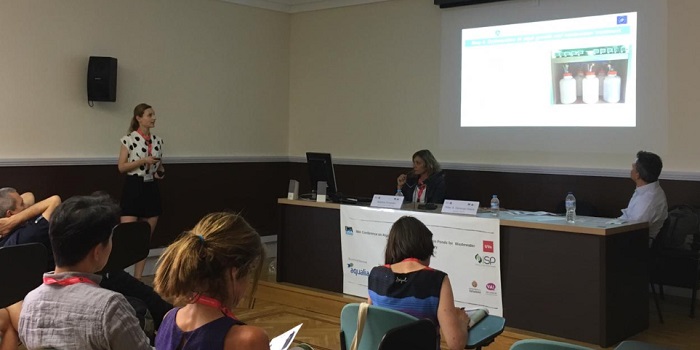On July 1 and 2, the IWAlgae 2019 congress was held at the University of Valladolid (UVa), a joint conference that included the II Congress of the International Association of Water on Algae Technologies for Wastewater Treatment and the Recovery of Resources and the XII Congress of the Specialist Group of the International Association of Water in Wastewater Technology.
The event has brought together algae experts nationally and internationally to exchange the latest advances on the application of photosynthetic microorganisms for wastewater treatment and resource recovery, as well as the use of traditional open pond systems and the use of photobioreactors.
The CARTIF technology center has contributed its bit by sharing its knowledge in this field based on its activity in the LIFE ALGAECAN project, of which it is the coordinator. This initiative aims to develop a demonstration plant for a model of sustainable wastewater treatment from the fruit and vegetable processing industry, through the profitable cultivation of heterotrophic microalgae. This will allow obtaining high-quality effluents that can be reused (for example, in irrigation and cleaning) or discharged into riverbeds, while reducing the cost of fruit and vegetable processing and eliminating the environmental impact associated with the generation of waste in the form of sludge, as is the case with traditional aerobic treatment systems and its usual landfill disposal.
Throughout the event, various current issues in the sector have been discussed:
• Advances in wastewater pond technology (case studies and fundamental research).
• Algae-bacteria-pathogens / virus interactions.
• Algae-based biorefineries.
• Bacterial algae and microbial ecology interactions.
• Photo-bioreactors of algae and bacteria for wastewater treatment.
• Biofuels from photosynthetic microorganisms.
• Experimental methods, algal respirometry, monitoring, modeling and process control.
• Collection technologies.
• Life cycle assessment.
• Technologies based on macroalgae.
• Molecular mechanism for carbon and nitrogen uptake.
• Treatment of wastewater based on purple photosynthetic bacteria.
• Waste gas treatment and greenhouse gas capture (including biogas improvement).
The treatment of wastewater with photosynthetic microorganisms can benefit from the knowledge derived from the use of algae to produce biofuels, food supplements or ecological pharmaceuticals and from the microbial physiology of purple photosynthetic bacteria. Similarly, wastewater as a cheap source of nutrients and inorganic carbon holds promise for the mass production of algae-based products. For example, microalgae-based treatment systems in developing and tropical countries can reduce the costs of wastewater treatment through the recovery of its inherent resources, while providing effective sanitation services.
This congress has provided a unique platform for analysis and discussion of the latest scientific developments and practical applications in a field of research that has grown exponentially in the past decade. The figures speak for themselves: the number of publications on the use of microalgae for wastewater treatment has increased from 60 in 2007 to more than 1000 in 2017.

